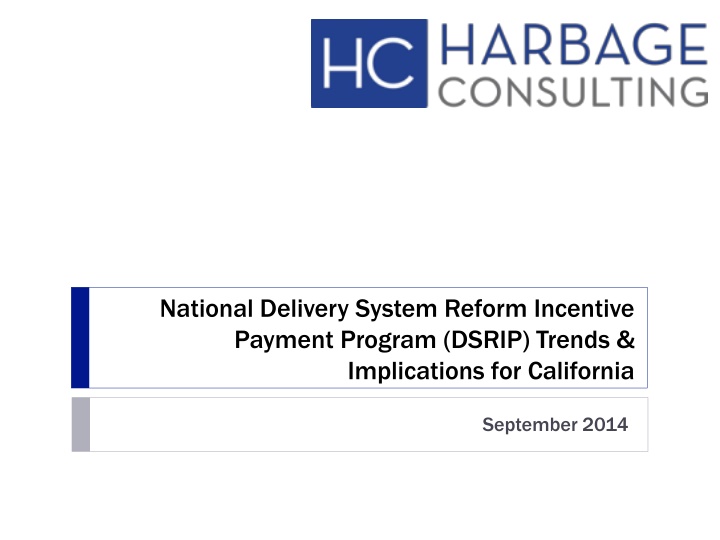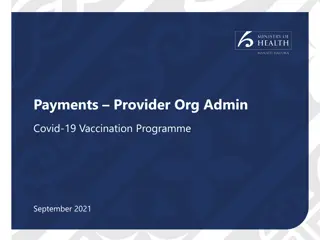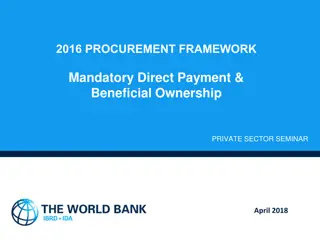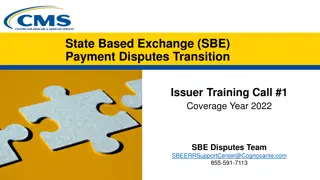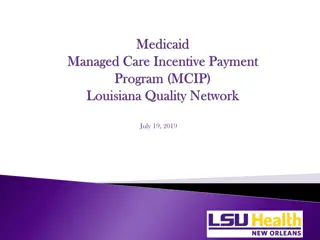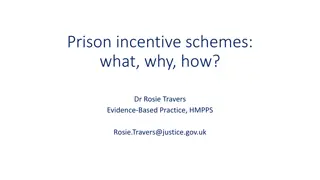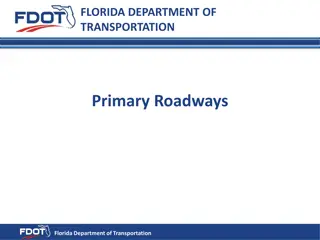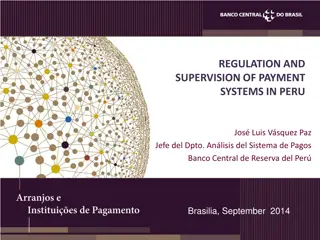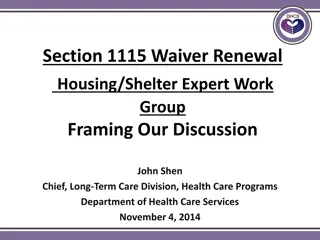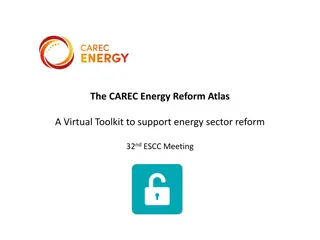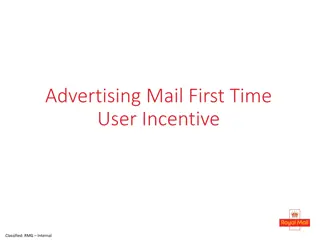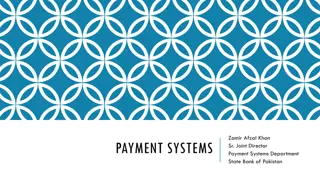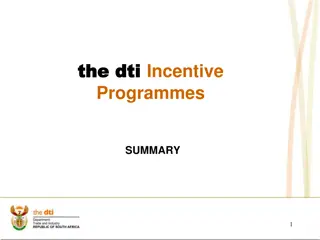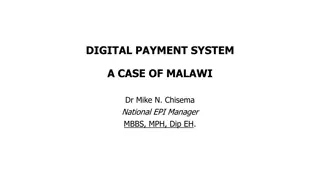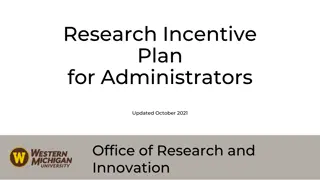National Delivery System Reform Incentive Payment Program Trends
Explore the National Delivery System Reform Incentive Payment Program (DSRIP) and its implications for California. Learn about DSRIP's objectives, characteristics, and progressive milestones. Understand how DSRIP aims to enhance patient care, improve outcomes, and reduce costs through collaborative efforts. Discover the innovative finance framework of DSRIP in New York and the implementation status in various states.
Uploaded on Mar 17, 2025 | 0 Views
Download Presentation

Please find below an Image/Link to download the presentation.
The content on the website is provided AS IS for your information and personal use only. It may not be sold, licensed, or shared on other websites without obtaining consent from the author.If you encounter any issues during the download, it is possible that the publisher has removed the file from their server.
You are allowed to download the files provided on this website for personal or commercial use, subject to the condition that they are used lawfully. All files are the property of their respective owners.
The content on the website is provided AS IS for your information and personal use only. It may not be sold, licensed, or shared on other websites without obtaining consent from the author.
E N D
Presentation Transcript
National Delivery System Reform Incentive Payment Program (DSRIP) Trends & Implications for California September 2014
What is DSRIP? 2 2 A new-ish Medicaid effort operated under a Section 1115 Medicaid waiver program that provides provider financial incentives to: Support delivery systems changes to meet the triple aim; Address gaps in care delivery; Improve hospital operations; and, Increase care capacity. States use federal dollars with a match. Budget Neutrality rules apply.
There is no definition, but DSRIPs seem to share certain traits. 3 3 Better patient care & experience through a more efficient, patient-centered and coordinated system. Decision-making process takes place in the public eye, ensuring processes are clear and aligned across providers. Collaborative process reflects the needs of the communities and inputs of stakeholders. Patient Centered Transparent Collaborative Providers are held to common performance standards, deliverables and timelines. Accountable Focus on increasing value to patients, community, payers and other stakeholders. Value Driven Better Health. Better Outcomes. Reduced Costs. Better Health. Better Outcomes. Reduced Costs.
DSRIP Means New Effort 4 4 DSRIP is new work for better outcomes. DSRIP is new work for better outcomes. Medicaid has a long history of providing supplemental payments for volume of care. The entire point of DSRIP is to move past notions of a federal subsidy (like DSH).
Progressive Milestones 5 5 DSRIP is fundamentally an incentive payment model. FFS and managed care payments still happen. DSRIP plans have: Incentive payments for meeting relative progress measurements, growing more difficult overtime. Some states allow partial recognition for partial achievement; others do not. Payments in early years are generally for process measures; outcome measures in later years. Beyond improved health outcomes, goals include: Better IT integration Provider integration State Department integration
DSRIP Finance Framework (NY) 6 6 Outcome Metrics & Avoidable Hospitalization $ Process Metrics Population Health Measures Time
DSRIP States (Implemented)* * Arizona s program was never implemented. Florida and Oregon operate DSRIP-like programs, but don t seem to be considered full DSRIP by CMS. ** New Jersey hospitals encouraged (not required) to work with downstream providers and share payments. *** New York has a linked statewide 25% reduction in avoidable hospitalization goal that reduces all provider payments if the entire state does not reach that goal. 7 7
DSRIP: Smaller Programs 8 8 Smaller programs include: Kansas limited program involving 2 safety net hospitals, limited standardization of metrics and milestones Massachusetts limited program involving 7 public and private safety net hospitals; limited standardization of metrics or projects; a significant focus on payment reform or alternative payment strategies New Mexico limited to sole community providers and state teaching hospitals; protocols still in development but each provider has own set of projects Kansas Massachusetts New Mexico
DSRIP: Larger Programs 9 9 There are currently seven states total implementing a DSRIP program: California 21 public hospitals generally in large, urban counties; limited standardization of metrics or projects New Jersey 63 hospitals, however hospitals strongly encouraged to work in partnership with other providers; highly tailored menu set of projects & metrics; providers asked to choose a public health goal that all projects had to be linked to New York broad program involving a large number of collaborations (40+) including social service providers, very tailored menu set, statewide goal of reducing avoidable hospitalization by 25% Texas broad program involving 20+ regional groups, menu of projects still broad but attempt to standardize metrics and milestones California New Jersey New York Texas
Comparison of DSRIP CA, TX & NY California Texas New York Delivery System Reform Incentive Program (DSRIP) November 2010 Delivery System Reform Incentive Pool (DSRIP) December 2011 Delivery System Reform Incentive Payment (DSRIP) Program February 2014 Program Title Waiver Approved CMS Approval of DSRIP Framework CMS Approval of Individual Plans Duration Federal Funding Available March 2011 Sept 2012 Protocols still in development March 2011 June 2013 Jan-Mar 2014 5 Years 5 Years 5.5 Years $3.3B $5.7B $6.9B 20-40 Performing Provider Systems (thousands of public & private providers) Participating Entities 20 Regional Healthcare Partnerships (330 public & private providers) 21 Public Hospitals 1. Infrastructure Development Innovation and Redesign Population-Focused Improvement Urgent Improvement in Care LIHP HIV Transition 1. 2. Infrastructure Development Program Innovation and Redesign Population-Focused Improvement Urgent Improvement in Care 1. 2. 3. 4. Overall Project Progress System Transformation Clinical Improvements Population-Wide Strategy Implementation 2. 3. DSRIP Category Title 3. 4. 4. 5. Project Menu Size 298 Milestones 1,322 Projects, varying milestones 44 Projects with specific milestones
DSRIP: Changing Role? 11 11 Originally, DSRIP initiatives were more narrowly focused on funding for safety net hospitals and often grew out of negotiations between states and HHS over the appropriate way to finance hospital care. Now, however, they increasingly are being used to promote a far more sweeping set of payment and delivery system reforms. Kaiser Family Foundation, October 2014 Kaiser Family Foundation, October 2014
How Does NY DSRIP Work? 12 12 Performing Provider Systems go through a number of steps to Performing Provider Systems go through a number of steps to implement DSRIP: implement DSRIP: NYS established targeted programs with a menu of projects. One provider in each region (PPS) is designated as the lead; regions can overlap. Participating providers select projects off the menu. DSRIP plans have progressively difficult milestones. Providers work to achieve the milestones, taking on the risk of missing the milestone. There must be a source of permissible funds to match federal dollars.
Broad Trends in DSRIP Programs 13 13 CMS generally has moved towards: Narrower menu of projects with pre-approved metrics and milestones. Collaboration with, and inclusion of, a broad range of providers, including social service providers. Stretch goals. DSRIP accountability bar is being set higher in each state. DSRIP goal is statewide payment reform. More upfront planning with CMS planning funds. Standardized and streamlined data reporting.
For more information, visit: www.harbageconsulting.com or contact us at: peter@harbageconsulting.com lisa@harbageconsulting.com 14 14
